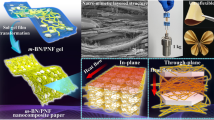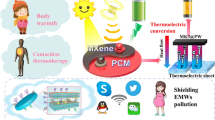Abstract
Aimed at settling the bottleneck problems of low flame retardancy for silicone rubber (SR), a modified melamine polyphosphate (H-Ni@MPP) was successfully obtained by successively introducing Ni2+ and silicon resin via a facile approach. Simultaneously, expandable graphite (EG) was further taken advantage of improving the flame-retardant ability. Surprisingly, the highest flame retardancy of SR/H-Ni@MPP/EG composites could be achieved with 49.5% LOI value and UL-94 V-0 rating when the loading was 40 phr. Moreover, flame retardancy after water treatment was dramatically maintained, revealing that the water resistance of SR composites was enhanced. The effect of H-Ni@MPP/EG ratio on the flame retardancy of SR was systematically investigated. Based on the analysis for remnants, the effective flame-retarding mechanism of SR composites can be ascribed to the physical–chemical intumescence, graphitized char layer and Ni-catalyzed process. Therefore, this strategy has provided an effective route for realizing the goal in flame-retarding SR composites.






Similar content being viewed by others
References
Zhang C, Wang J, Song S. Preparation of a novel type of flame retardant diatomite and its application in silicone rubber composites. Adv Powder Technol. 2019;30:1567–75. https://doi.org/10.1016/j.apt.2019.05.002.
Yan H, Dai X, Ruan K, Zhang S, Shi X, Guo Y, et al. Flexible thermally conductive and electrically insulating silicone rubber composite films with BNNS@Al2O3 fillers. Adv Compos Hybrid Mater. 2021;4:36–50. https://doi.org/10.1007/s42114-021-00208-1.
Hermansson A, Hjertberg T, Sultan BÅ. The flame retardant mechanism of polyolefins modified with chalk and silicone elastomer. Fire Mater. 2003;27(2):51–70. https://doi.org/10.1002/fam.817.
Zhang Z, Liu Y, Yang K, Cheng D, Li S, Li Z. Reversible thermochromic microencapsulated phase change materials for enhancing functionality of silicone rubber materials. Mater Chem Phys. 2022;290: 126564. https://doi.org/10.1016/j.matchemphys.2022.126564.
Rahimi-Aghdam T, Shariatinia Z, Hakkarainen M, Haddadi-Asl V. Nitrogen and phosphorous doped graphene quantum dots: Excellent flame retardants and smoke suppressants for polyacrylonitrile nanocomposites. J Hazard Mater. 2020;381: 121013. https://doi.org/10.1016/j.jhazmat.2019.121013.
Qiu J, Wu T, Qu J. Fabrication of iron oxide nanoparticle decorated boron nitride nanosheet for flame-retarding silicone rubber. Mater Lett. 2021;283: 128712. https://doi.org/10.1016/j.matlet.2020.128712.
Sarath P, Biswal M, Mohanty S, Nayak SK. Effect of silicone rubber based impact modifier on mechanical and flammability properties of plastics recovered from waste mobile phones. J Clean Prod. 2018;171:209–19. https://doi.org/10.1016/j.jclepro.2017.10.024.
Xu T, Wang S, Wang H, Xu T. Inhibitory effects of developed composite flame retardant on bituminous combustion and volatile emissions. J Clean Prod. 2021;279: 123538. https://doi.org/10.1016/j.jclepro.2020.123538.
Kim Y, Hwang S, Choi J, Lee J, Yu K, Baeck SH, et al. Valorization of fly ash as a harmless flame retardant via carbonation treatment for enhanced fire-proofing performance and mechanical properties of silicone composites. J Hazard Mater. 2021;404: 124202. https://doi.org/10.1016/j.jhazmat.2020.124202.
Ys A, Yw A, Yu YB, Hj A, Yq A, Bsu C, et al. Development of environmentally friendly flame retardant to achieve low flammability for asphalt binder used in tunnel pavements. J Clean Prod. 2020;257: 120487. https://doi.org/10.1016/j.jclepro.2020.120487.
Hong L, Hu X. Mechanical and flame retardant properties and microstructure of expandable graphite/silicone rubber composites. J Macromol Sci B. 2016;55(2):175–87. https://doi.org/10.1080/00222348.2015.1138029.
Qiu J, Lai X, Li H, Gao J, Zeng X, Liao X. Facile fabrication of a novel polyborosiloxane-decorated layered double hydroxide for remarkably reducing fire hazard of silicone rubber. Compos Part B-Eng. 2019;175: 107068. https://doi.org/10.1016/j.compositesb.2019.107068.
Pang Q, Kang F, Deng J, Lei L, Lu J, Shao S. Flame retardancy effects between expandable graphite and halloysite nanotubes in silicone rubber foam. RSC Adv. 2021;11:13821–31. https://doi.org/10.1039/D1RA01409A.
Zhao X, Wang D, Alonso JP, Wang D. Inclusion complex between beta-cyclodextrin and phenylphosphonicdiamide as novel bio-based flame retardant to epoxy: inclusion behavior, characterization and flammability. Mater Design. 2017;114:623–32. https://doi.org/10.1016/j.matdes.2016.11.093.
Dong X, Ma Y, Fan X, Zhao S, Xu Y, Liu S, et al. Nickel modified two-dimensional bimetallic nanosheets, M(OH)(OCH3) (M=Co, Ni), for improving fire retardancy and smoke suppression of epoxy resin. Polymer. 2021;35: 124263. https://doi.org/10.1016/j.polymer.2021.124263.
Wu X, Hong X, Luo Z, Hui KS, Chen H, Wu J, et al. The effects of surface modification on the supercapacitive behaviors of novel mesoporous carbon derived from rod-like hydroxyapatite template. Electrochim Acta. 2013;89:400–6. https://doi.org/10.1016/j.electacta.2012.11.067.
Cabrera-Álvarez EN, Ramos-deValle LF, Sánchez-Valdes S, Candia-García A, Soriano-Corral F, Ramírez-Vargas E, et al. Study of the silane modification of magnesium hydroxide and their effects on the flame retardant and tensile properties of high density polyethylene nanocomposites. Polym Composite. 2013;35(6):1060–9. https://doi.org/10.1002/pc.22753.
Pang Y, Tian Y, Shi X. Synergism between hydrotalcite and silicate-modified expandable graphite on ethylene vinyl acetate copolymer combustion behavior. J Appl Polym Sci. 2017;134(12):44634. https://doi.org/10.1002/app.44634.
Yuan B, Chen L, Bao C, Qian X, Song L, Tai Q, et al. Design of artificial nacre-like hybrid films as shielding to mitigate electromagnetic pollution. Carbon. 2014;75:178–89. https://doi.org/10.1016/j.carbon.2014.03.051.
Li J, Ke C, Xu L, Wang Y. Synergistic effect between a hyperbranched charring agent and ammonium polyphosphate on the intumescent flame retardance of acrylonitrile-butadiene-styrene polymer. Polym Degrad Stabil. 2012;97(7):1107–13. https://doi.org/10.1016/j.polymdegradstab.2012.04.005.
Zhang L, Wu W, Li J, Wang Z, Wang L, Chen S. New insight into the preparation of flame-retardant thermoplastic polyether ester utilizing β-cyclodextrin as a charring agent. High Perform Polym. 2017;29(4):422–30. https://doi.org/10.1177/0954008316648004.
Zheng Z, Liu Y, Zhang L, Wang H. Synergistic effect of expandable graphite and intumescent flame retardants on the flame retardancy and thermal stability of polypropylene. J Mater Sci. 2016;51:5857–71. https://doi.org/10.1007/s10853-016-9887-6.
Zheng Z, Liu Y, Zhang L, Dai B, Yang X, Wang H. Fabrication of halogen-free ammonium phosphate with two components via a simple method and its flame retardancy in polypropylene composites. J Thermal Anal Calorim. 2017;127:2013–23. https://doi.org/10.1007/s10973-016-5779-x.
Sun J, Yu Z, Wang X, Wu D. Synthesis and performance of cyclomatrix polyphosphazene derived from trispiro-cyclotriphosphazene as a halogen-free nonflammable material. ACS Sustainable Chem Eng. 2014;2(2):231–8. https://doi.org/10.1021/sc400283d.
Wang X, Song L, Yang H, Lu H, Hu Y. Synergistic effect of graphene on antidripping and fire resistance of intumescent flame retardant poly(butylene succinate) composites. Ind Eng Chem Res. 2011;50(9):5376–83. https://doi.org/10.1021/ie102566y.
Magdas DA, Cozar O, Chis V, Ardelean I, Vedeanu N. The structural dual role of Fe2O3 in some lead-phosphate glasses. Vib Spectrosc. 2008;48(2):251–4. https://doi.org/10.1016/j.vibspec.2008.02.016.
Chen X, Chen X, Zhang F, Yang Z, Huang S. One-pot hydrothermal synthesis of reduced graphene oxide/carbon nanotube/α-Ni(OH)2 composites for high performance electrochemical supercapacitor. J Power Sources. 2013;243:555–61. https://doi.org/10.1016/j.jpowsour.2013.04.076.
Acknowledgements
This work was supported National Natural Science Foundation of China, China (grant number 52005050), Foundation of State Key Laboratory of Automotive Simulation and Control, China (grant number 20201105), Science and Technology Development Project of Jilin Province, China (grant number YDZJ202201ZYTS334) and Science and Technology Research Project of Education Department of Jilin Province, China (grant number JJKH20220679KJ).
Author information
Authors and Affiliations
Corresponding author
Ethics declarations
Conflict of interest
The authors declare no competing interests.
Additional information
Publisher's Note
Springer Nature remains neutral with regard to jurisdictional claims in published maps and institutional affiliations.
Rights and permissions
Springer Nature or its licensor (e.g. a society or other partner) holds exclusive rights to this article under a publishing agreement with the author(s) or other rightsholder(s); author self-archiving of the accepted manuscript version of this article is solely governed by the terms of such publishing agreement and applicable law.
About this article
Cite this article
Chai, W., Su, X., Xia, Y. et al. Fabrication of Ni-doped synergistic intumescent flame-retarding silicone rubber system with superior flame retardancy and water resistance. J Therm Anal Calorim 148, 1827–1839 (2023). https://doi.org/10.1007/s10973-022-11865-9
Received:
Accepted:
Published:
Issue Date:
DOI: https://doi.org/10.1007/s10973-022-11865-9




